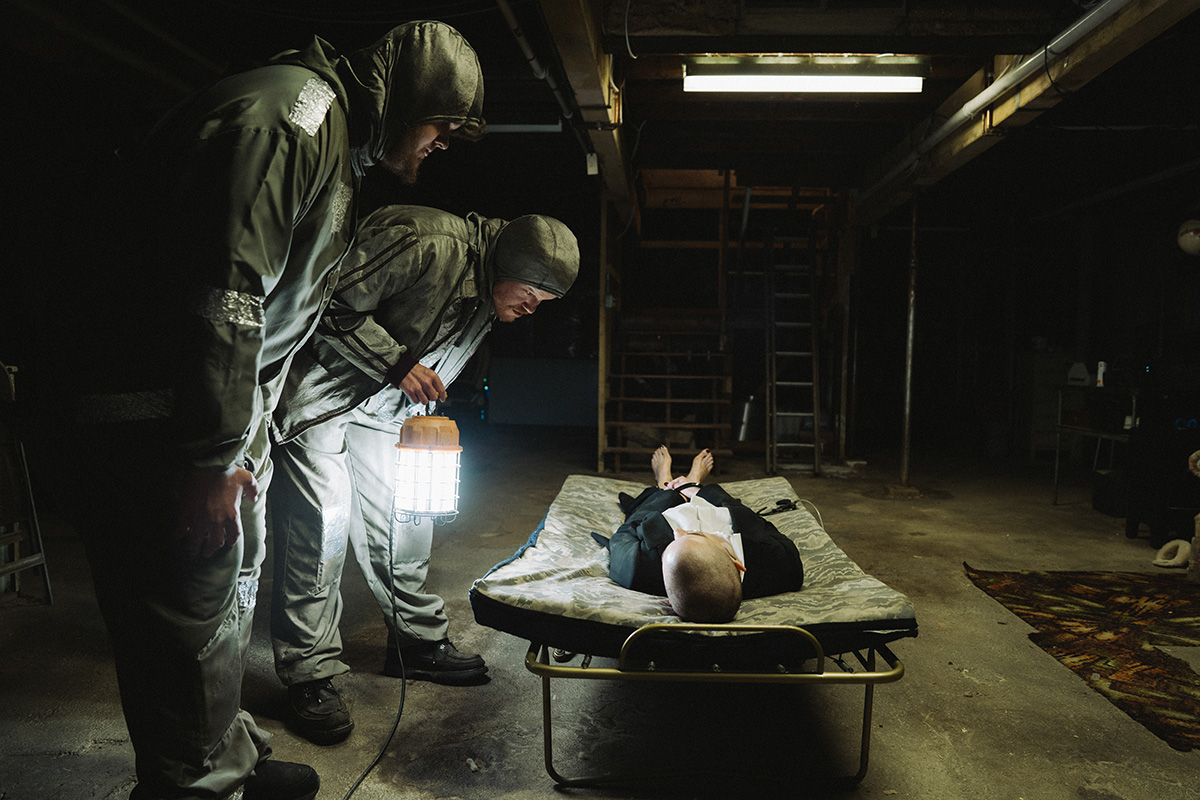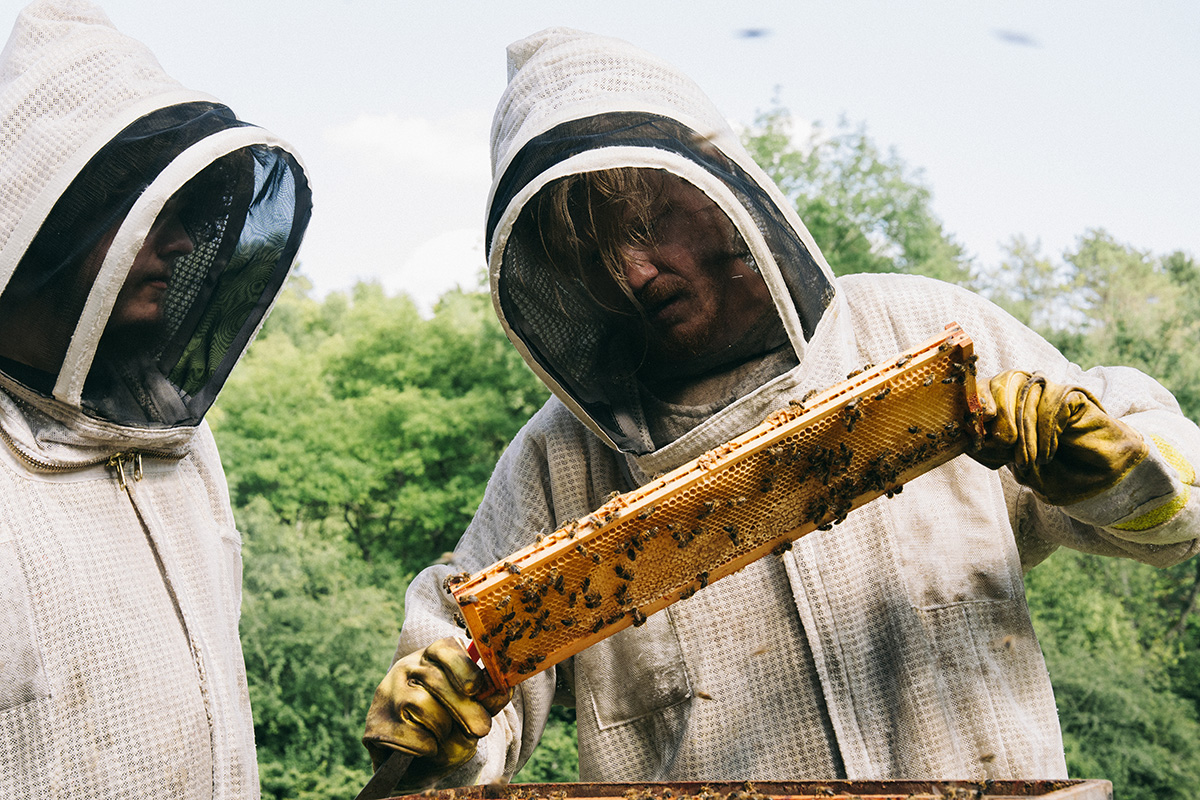Bugonia is a brutal analysis of how conspiratorial thinking infects reality and why debunking and fact-checking are losing to madness.
Table of Contents
Calling Yorgos Lanthimos’s Bugonia (2025) a comedy—or even a black comedy—is, in my opinion, a fundamental misunderstanding. Yes, there are elements of humor here, but it’s the kind that gets stuck in your throat. In essence, it is a drama with residual elements of the grotesque, serving not entertainment, but a critical turn: turning paranoid interpretation against the observer. Let’s put a mirror in front of ourselves and take a look. Can we still do that?
This film is a vivisection of a mind infected by a conspiracy theory. Although I avoid direct plot spoilers in the text below, I must warn you: Bugonia can be brutal. Even for me, some scenes were very intense. However, this violence is not an aesthetic accessory. It is an essential tool to demonstrate the real, physical consequences of over-interpreting reality—the path from paranoid thinking to crime, where we vivisect reality to confirm the existence of the signals and signs we expect to find.

From the Fringes to the Mainstream: The End of “Subculture”
I am pleased by this film’s presence in mass culture, and especially by the way it portrays the mechanisms of radicalization. Just a decade ago, writing about the heroes of Bugonia—kidnappers firmly convinced that the CEO of a powerful pharmaceutical company (played by Emma Stone) is an alien bent on destroying humanity—I would have used the word “subculture.”

Today, that word is inadequate. What we see on the screen is a fictionalization of phenomena described in Michael Barkun’s excellent book “A Culture of Conspiracy”. Many conspiracy theory researchers warned about progressive radicalization, writing about “lone wolves,” which was confirmed by the lone wolf’s rifle raid on the Comet Ping Pong pizzeria to break up an alleged pedophile ring, or by madmen blocking highways. In turn, Gabriel Gatehouse’s “The Coming Storm” brilliantly analyzed the QAnon, MAGA, and accelerationist movements, which cynically pump up conspiracy theories for political and business purposes.
Why won’t I write about subculture anymore? Because conspiracy theories have ceased to be the domain of the fringe. They are now mainstream, thanks to Elon Musk and the MAGA international. But in other forms, these theories reside in all of us. I recently published an analysis of the paranoid theory about Biden-Cyborg. However, if you juxtapose this dehumanization of opponents with Bugonia and what dehumanization (the CEO as an alien) actually leads to, you see why it is so dangerous.
As Tomasz Stawiszyński rightly noted in one of his broadcasts, each of us carries the seed of conspiratorial thinking. I myself have witnessed a highly educated person in my circle, a doctor of art history, begin to repeat disinformation about the alleged agent-past of a former president. A quick check of the sources of these revelations led directly to troll farms and YouTube algorithms geared towards political polarization. This is not a problem of “stupid people.” It is a systemic problem and a problem of content consumption from the internet. Most importantly, it is not simple people who are the best ground for conspiracy theories, but precisely the educated, because they have the entire eristic toolkit to defend their concepts to the end.

Paranoia… a Pure Roar of Madness
The heroes of Bugonia—Teddy and his cousin—are not just criminals, but also victims of a brutal world. They are people who cannot cope with the injustice of the world, being victims of sexual and domestic violence, information chaos, and their own exclusion. They are cynically used by “PR specialists” from alternative media and self-proclaimed gurus like Elon Musk, who monetize fear and anger under the guise of “free speech.” They push them to burn down their own house because these gurus have a vision of how to rebuild it anew.
For a person cheated by a pyramid scheme, destroyed by pathological property development, or ground down by the bureaucratic machine, a conspiracy theory is a comfort. It provides simple answers to difficult existential questions. The brain needs predictability; it does not accept the abyss of the incomprehensible. Therefore, simple answers that structure the world allow one to regain a sense of agency—“I know something others don’t,” but also, “I understand what is happening.”

The most powerful element of the film are the interrogation scenes of the imprisoned CEO. She tries to falsify the kidnappers’ theses, to confront their paranoia with facts, putting the principles of critical thinking into practice. And what does the viewer see? That it is completely ineffective. This is a painful metaphor for the failure of modern fact-checking.
Why are we losing to disinformation? Because paranoid thinking changes semantics. Any evidence contradicting the theory is immediately absorbed by the theory as confirmation of the conspiracy (“If they deny it, it means they are part of the system!”).
This process begins with the devaluation of authorities. If you can convince the audience that universities are corrupt and science is just an opinion, a vacuum is created. Into this vacuum steps a sweaty guy from his basement recording YouTube videos. He becomes the new authority. Bugonia shows the final stage of this process—a pure roar of madness.
Bugonia vs. Save the Green Planet! – The Evolution of Fears

It is worth noting that Lanthimos’s film is a remake of the South Korean cult classic “Save the Green Planet!” (2003). A comparison of these two films perfectly shows how the world has changed over the last 20 years.
The original was an eclectic mix of slapstick and horror, and the hero’s madness stemmed from personal, physical trauma. Lanthimos, by transposing the story to the reality of 2025, shifts the emphasis:
- Online Radicalization: The new hero, Teddy, is “aggressively online.” His paranoia is not solitary—it is fed by algorithms and incel communities.
- Gender and Power: In the original, the victim was an old industrialist. In Bugonia, it is a modern woman, the CEO of a biotech company. This introduces a layer of misogyny and fear of female power, so characteristic of the contemporary “manosphere.”
- Tone: Instead of a chaotic carousel of genres, we get a suffocating, slow-burn thriller that is much more grounded in reality.
Critical Thinking Is Not Paranoid Thinking
I encourage you to watch Bugonia to the very end. The final twist is not meant to prove the kidnappers right. It serves to show that the real threat lies elsewhere.
One of the first texts on dadalo.pl was about the opioid pandemic and the Sackler family. That was an example of a real conspiracy—the cynical actions of the Purdue Pharma corporation, documented and proven.
The paradox of our time is that by escaping into fantasies about aliens and reptilians, we lose sight of real abuses. Critical thinking is about asking tough questions of corporations and governments, but based on facts, not delusions. If we allow pathologies (in banking, medicine, urban planning) to go unpunished, we will be fertilizing the ground for the next waves of conspiracism.
Watch this film with an open mind. Don’t just relate it to “internet crazies.” Relate it to yourself.
Bibliography and Inspirations (real, physical, not generated by ChatGPT):
- Michael Barkun, “A Culture of Conspiracy”
- Gabriel Gatehouse, “The Coming Storm”
- Broadcasts and essays by Tomasz Stawiszyński
- Universal Pictures press materials
The mention of the attack on the Comet Ping Pong pizzeria (Pizzagate) refers to events for which visualizations (e.g., by Becker1999, available under a CC BY 2.0 license) can be found in public resources such as Wikipedia or Flickr.


